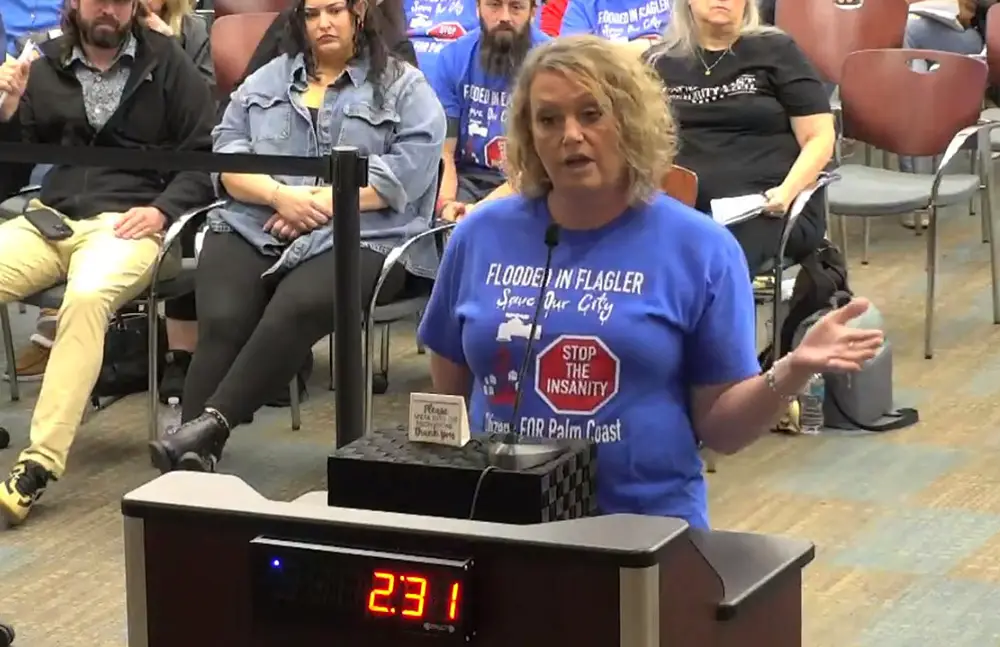
Last Updated: 5:57 p.m.
An attempt by Palm Coast City Council member Theresa Pontieri to enact a 45-day moratorium on home construction in Palm Coast’s “infill” lots failed today. But the council approved creating a citizens’ advisory board focused entirely on flooding problems tied top new home construction, while also approving the accelerated enactment of a series of related regulations Pontieri was urging. Pontieri, however, voted against that measure.
The motions and votes were scattered over a two-and-a-half hour segment of a council meeting that went double that length today. It featured dueling contenders and exaggerations on both sides over the issues.
Ramparts of builders wearing Flagler Home Builders Association-logo shirts were on one side, warning against a building moratorium in critical and dire terms that projected layoffs and sharp economic harm. Residents clad in louder-colored or stenciled shirts (“PALM COAST LOUDMOUTH MINORITY CLUB,” “FLOODED IN FLAGLER,” “STOP TE INSANITY”) were on the other, many of them quite dry but eager to lend support for a moratorium and outrage against what they perceive as a council deaf to their complaints about development.
“I did not want to declare war on the builder and development community. That is not my goal,” Pontieri said. “But I am not a lobbyist for the building community. I’m an elected official. And it’s not my job to well, yes, we have to protect our industries here. We have to protect our businesses here. I get all of that and I appreciate that. But I have to protect my residents, too.” She called for strengthening the city’s Land Development Code and the technical manual regulating construction.
“How is it that we can possibly say we’re protecting our residents by saying nope, moratorium off the table and we can just move forward,” she said, citing nine Florida cities that did moratoriums or temporary pauses “because of this very reason.” As Council member Nick Klufas verified, those moratoriums were not related to Palm Coast’s specific issue: none had issues similar to Palm Coast’s. Pontieri didn’t dispute the fact. But she said the Palm Coast approach is far more narrowly tailored, the point being that moratoriums are not in and of themselves heretical. She urged “a 90-day pause while we finish looking at these last final issues.”
The final issues, however–such us silt fencing, guttering rules, additional inspections–were beyond the scope of the original problem, or at least looked like new issues that cropped up only recently. With its reference to the much broader Land Development code, whose revisions can take months, and goalpost-shifting criticism of details within the technical manual, Pontieri’s call for a moratorium seemed to have lost some of its earlier focus, making it more vulnerable. Combined with the earlier decision to establish an advisory board and with Alfin’s suggestion that the city could start addressing Pontieri’s more specific concerns right away, the call seemed doomed to defeat, even as she called it “a build at all cost” approach that could set the city up for liability.
Pontieri was critical of the decision by city staff to concede to all the changes requested to the technical manual by the Flagler Home Builders Association. “If our internal staff who we trust to make decisions on and advise us up here and make decisions on behalf of the residents have added requirements into the technical manual that were then removed per the HBA input, why is that?” she asked. Cote said some of the changes, such as those addressing gutters, would have trumped the state code, which the city did not want to do. But various issues in the technical manual led Pontieri to conclude that the work wasn’t done yet.
“It’s not going to fix everything because clearly we still have more research that needs to be done,” Pontieri said. “So to just automatically back off of a pause on building that, by the way, I do not want to do–that is not my goal. But if we are not sure that the steps that we are taking today are going to solve the problem because there’s more research to be done, then we need to be diligent and do the research.” Pontieri also cited what she described as “an enforcement issue,” and what the city could do to enforce the city’s own code to prevent improper water runoff. That’s not being done, she said.
Alfin called the 90-day moratorium “arbitrary,” and suggested the advisory committee could itself recommend a moratorium in the future. Pontieri said that would only lead to more construction that would potentially create issues. She was willing to draw back to a 45-day pause. But by the time she made the motion, she drew no second. It died.
Yet another motion by Danko to address the trio of more specific issues Pontieri raised passed. Even though the moratorium matter had died, it was to that issue–not to the Danko motion, which had nothing to do with a moratorium–that most of the public comments were directed: the chamber was filled with people ager to speak their piece, so they did.
“The motion for a moratorium feels as though it was made in an effort to force the hand of the stormwater department and to punish the private sector for not doing what council wanted them to do and the timeframe they want it,” Annamaria Long, executive officer of the Home Builders Association, said, outlining the HBA’s meetings and roundtables on the issue. “We were engaged and we were doing everything that was asked of us.” Long then said a pause would lead to close to $60 million in lost income, including $42 million in local wages and close to 1,000 jobs potentially lost. “Using a moratorium to help residents in one area and in the same breath putting other residents out of work and new homeowners paying additional loan fees seems like a bad idea,” Scott Sowers, president of Cline Construction, said.
Leslie Johnson paraphrased the Declaration of Independence–with a little license endowing the document with a reference to privacy–to claim that a flooded resident has “cannot live in her home as it is. She has fear. She has loss of liberty. She has loss of life. And loss of the pursuit of happiness.” Others spoke explicitly in support of a moratorium, one resident describing a neighboring construction that has risen higher than the fire hydrant by the street. “I’ve done construction for most of my life. I understand what it’s like to have to put a pause on things. And we’re all trying to make ends meet,” the resident said. “But it shouldn’t be the financial burden of homeowners who have to bear the weight of that.” A Palm Coast resident who described himself as owning a business in the construction industry called “a blatant lie’ that a pause would cause layoffs. “For every job I take I turned down 10,” he said.
After public comment on Danko’s motion, but before the vote, Alfin stepped out for a moment, and with Danko–the vice mayor–in charge, Danko, after interrupting Pontieri, swiftly ordered a person in attendance thrown out for answering “yes” when Danko had warned the crowd not to interrupt proceedings, and asked, “you want to test me?”
The man who was actually thrown out is Peter Johnson, a candidate for mayor, who said he had not been the one to yell out “yes” in response to Danko’s dare. “It wasn’t a random person, it was someone who spoke against Ed yesterday,” Johnson said, referring to himself, and why he was thrown out. “It was retaliation, I believe.” Danko disagrees: “It was Peter Johnson who loudly, rudely interrupted our council meeting, and he did not heed my warning, instead silently mouthing ‘I dare you’ before I had him removed,” Danko said in a text. “This was not retaliation, and I have no knowledge of him speaking against me yesterday. The deputy had no problem quickly identifying Mr. Johnson from the crowd as the disruptor.”
Though it was on her concerns’ behalf, Pontieri before the vote voiced her opposition to Danko’s motion, calling it “misguided and haphazardly put forward in an effort to continue to build build build rather than do what’s right.” Danko’s motion passed 4-1.
The beginning of the two-and-a-half-hour segment had been devoted to the latest presentation by city staff on where matters stand with flooded properties and the city’s response, with another brief summary on the genesis of it all.
ITT platted 48,476 lots when Palm Coast was designed, before it was a city, in the late 1960s. Of those, 9,335 remain vacant. They are referred to as “infill” lots, because when houses are built there, that construction “fills in” acreage designed for the purpose, in contrast with more sprawl-like subdivision development that goes beyond the old ITT boundaries (like new development rising west of U.S. 1, for example), or subdivisions on larger, still-empty acreage within the old boundaries, though very few of those are left.
As new homes have been built of these infill lots, many have risen on fill bases comparatively much higher than Existing residents have The city is working on 163 cases, 97 of them having already received site visits from city staffers. The rest should be completed by month’s end. In some cases, the water flow has more to do with existing property owners’ lots than with the new construction. The two may be related, but the new construction is not at fault for causing water retention on existing lots, as the city sees it.
“Existing homes are retaining their own stormwater,” Stevens said. “They’re required under our existing codes and building codes that they have to retain their own stormwater. They cannot drain stormwater onto adjacent properties. A lot of the items that we’re seeing out there is just natural ground compaction.” Compaction is when land “settles” over time. “We’re seeing a lot of the homes that have had compaction throughout the years,” Stevens said. “We’ve seen some areas where they’ve removed trees and change the direction of flow across the property. We’re also seeing that sometimes landscaping is making a difference in how flood water flows off properties.”
By Florida law, the finished floor elevation must be a minimum of 12 inches above the crown of the road in front of the house. “We’ve established an absolute maximum both 22 inches above the crown of the road and no more than 10 inches above the adjacent properties,” toi the left and right of existing properties only, Stevens said. That’s the key new addition to the technical manual. Other changes, such as delimiting the front property line to the edge of the road, rather than to the swale, will also help lower the back elevation of a property, and lower the finished floor elevation. Further technical manual updates are being considered, such as guttering.
“We’re going to finish updating our technical manual and get it implemented as soon as possible. We have unofficially been utilizing the standards already in the field,” Stevens said.
According to Council member Cathy Heighter, there are elevations higher than 22 inches. The city concedes that those homes exist, when measured against the road crown, though compared to houses next door, they’re 16 to 20 inches higher. “What people think it looks like two feet or three feet isn’t as high as you may think,” Cote, the city’s stormwater and engineering director, said. Either way, the new technical manual rules will lower elevations.
“It appears to me that we’re headed in the right direction with this. I just want you guys to be able to assure the public that we’re not going to have this problem moving forward,” Danko, who had been at the origin of the push to address residents’ flooding concerns, said. Cote assured him that the changes will make a difference. “Hopefully we have solved this problem moving forward. I see no point today in pushing for any temporary pause and construction of single family homes on infill lots,” he continued, before grumbling from the full chamber interrupted him, and Mayor David Alfin had to issue his first caution to the audience.
Danko–who compared the ongoing flooding issue to the wildfires of 1998, crisis-wise, and framed the matter as a way to unify the community–instead made his motion to establish the Citizens Advisory Committee that would explore flooding problems and report potential solutions back to the council, “and then explore all options to help these folks, including, but not limited to some financial assistance.” A council member and city staff would be appointed to the committee as a liaison. Council member Theresa Pontieri seconded. The motion passed unanimously.
“This is not going to solve something over night. But this is going to give everybody a voice and give everybody an opportunity to work to solving this,” Danko said.
![]()








